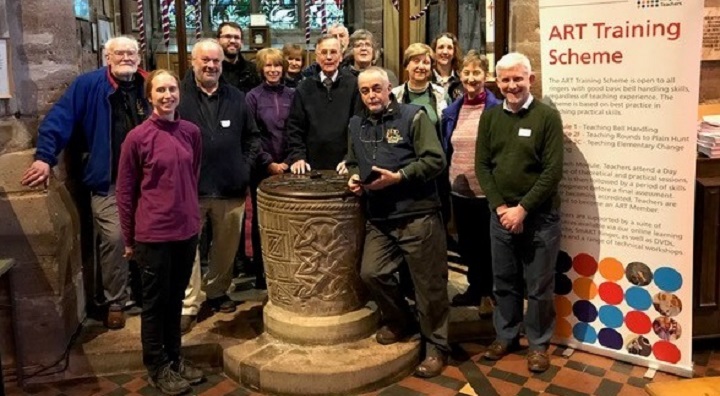M2C: 24 Feb 2018 - Edgmond
Why do the 2C Module?
I had already covered Modules 1 and 2F of the ART Training Scheme qualifying for full membership of the Association of Ringing Teachers and this has been highly useful in establishing a band from scratch in Brierley Hill. We have four learners (from scratch) who have just reached the stage of learning to Plain Hunt. As a relatively new ringer myself (four years) who has graduated through the Learning the Ropes scheme, thanks to the Birmingham School of Bell Ringing, I needed ideas to take our ringers to the next level. How do we help them develop the skills of: changing speed, counting places, understanding theory, and taking them on the first steps to method ringing? Even though I have been through these steps relatively recently as a learner, teaching them to someone else … that’s another thing. I needed help. So when a Module 2C Day Course was announced running at Edgmond, Shropshire, I was eager to sign up.
Edgmond
One of the pleasures of ringing is visiting different churches with some wonderful architecture. Edgmond is no exception to this. The 11th-Century church has an unusual sundial outside, some fine stained glass windows - including one designed by William Morris - and a ground floor ringing chamber for its eight bells. Ideally for a day’s ringing practice, the tower also has a ringing simulator. Keeping the supportive neighbours onside is important.
The Participants
The tutor for the day was Paul Lewis. He started proceedings with introductions. Unsurprisingly given its location, most of the participants were from churches in Shropshire and Herefordshire. It was encouraging listening to each in turn describing where they were in developing their learners. A good start: lots of tips were exchanged throughout the day, for which I am very grateful.
The Learning
Good teaching was encouraged throughout the day through three types of activity. Firstly: a pack of materials was provided for everyone to take away and use. The pack included: Teacher’s guides with lots of ideas for activities, a Ringer's Progress Book, a teaching log to fill in at least four lessons for evaluation later, and useful blue line diagrams and worksheets for use in the tower. Secondly: presentations, written by ART, were delivered at strategic points during the day. The presentations covered topics such as the background to ART, some teaching theory and the need for variety in teaching methods. Other topics were on how to run a tower and how to keep your learners motivated and engaged. The presentations are available to delegates on ART's SmART Ringer website. The third strand to the day was practical workshops - actually getting on with ringing. These were highly useful and a rich ground for developing ideas for teaching ringing.
The Workshops
Three practical workshops were organised. For me these were the most useful part of the day, with plenty of opportunity to learn new ideas and to pick up tips from practitioners. The workshops followed a learner’s journey from Rounds and Call Changes through key skills such as knowing your place, following a rhythm and changing speed skills, to moving from Plain Hunt to Plain Bob Doubles. Each step built on the previous one, with skills broken down to aid learning. So in the first workshop we explored how to improve ringers’ ability to change speed, enhance rhythm and enhance listening skills to improve striking. This involved exercises from ringing facing out, Switcharoo, whole pull and stand, and pulling off in different orders. Building on this the second workshop took us through the elements of Plain Hunt. Starting with leading skills, then through clapping exercises to develop rhythm and a sense of movement, the workshop gave practical experience of exercises to isolate each skill being developed. Finally, after a splendid lunch of homemade soup and rolls, we moved on to the third workshop. This examined moving from Plain Hunt to Plain Bob Doubles. In particular it focused on methods which could be used to practice particular pieces of work. These methods included Bastow, Cloister, Penultimate, Bayles and Funny Bob Doubles. The workshops were also an opportunity to exchange experiences and get tips from more experienced ringers.
In Conclusion
Overall the day was highly informative. In truth I’ve struggled in teaching some of my learners. The day gave lots of ideas on how to improve this. Paul was an excellent Tutor who gave clear explanations and was always willing to help. He also encouraged those present to exchange ideas and to bring new insights to the session. It was good to meet the other participants who made me feel very welcome. It is definitely a Day Course I would recommend to others.
Tim Sunter

Course Tutor: Paul Lewis
Teaching Elementary Change Ringing
Learn how to teach the skills of change ringing.
» Find out more about Module 2C